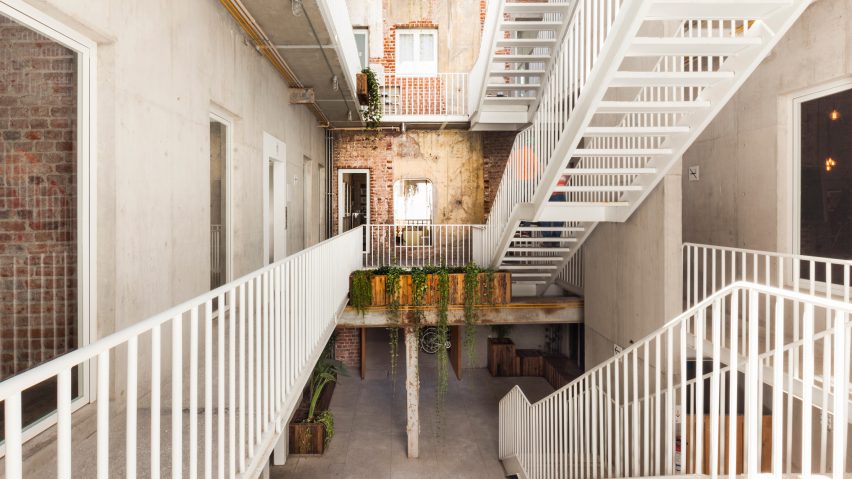Cadaval & Sola-Morales has converted a derelict block in Mexico City's La Roma neighbourhood into apartments, offices and shops set around a courtyard with white staircases and trailing planting.
The Spain- and Mexico-based practice carved out an atrium at the centre of the disused building named CH-Reurbano to give residents, workers and shoppers access to an open-air space.
The courtyard features exposed brick and concrete walls and an industrial-style white metal staircase covered in planting.
This new indoor courtyard, which creates a central circulation space, was devised to improve the building's structural stability.
A series of concrete walls were also added on the longer sides to further support the structure, while the new staircase connects all four levels.
"The existing construction operated truly like three separate buildings, with no connection within them, and had been abandoned for a few years," explained architect Kecho Quenke.
"Its structural stability was compromised due to a differential subsidence of its foundations," Quenke continued.
"By correcting the load of the structure, the new patio can operate as a new central circulation and as a ventilation system, which allows the building to function as an efficient unit."
The ground floor is occupied by a cafe, bakery and a bike shop, while small offices for start-up businesses and entrepreneurs are placed on the first floor.
Apartments of various sizes and configurations are located on the upper two levels with access to a roof garden that is planted with an orchard.
Cadaval & Solà-Morales also restored as much of the building's existing features as possible – an approach the architects also took for its renovation of a 1920s building in the same neighbourhood.
"The project is an exploration of an essential architecture, highlighting what is indispensable and removing what is not necessary," said Quenke. "The project seeks for a harmonic relationship between the new and the old."
Brick walls with plaster marks and concrete ceiling beams are left exposed, while original wooden floorboards, archways and door frames are restored, although still featuring peeling paintwork.
These are complemented by light interventions, including glass partitions in the offices, a wooden bench in the courtyard and pot plants.
Cadaval & Solà-Morales was founded by Eduardo Cadaval and Clara Solà-Morales in 2003, and has offices in both Spain and Mexico. Other projects by the firm include a black concrete holiday retreat in the countryside and a house comprised of ten cubes that point in different directions.
Photography is by Sandra Pereznieto
Project credits:
Architect: Cadaval & Solà-Morales.
Projectteam: Eduardo Cadaval & Clara Solà-Morales. Collaborators: Eduardo Alegre, Orsolya Maza.
Local architect: Eugenio Eraña Lagos,
Structural engineering: Ricardo Camacho de la fuente

